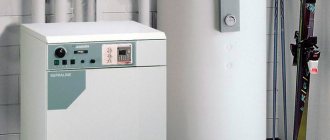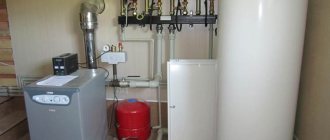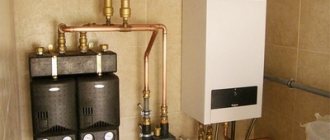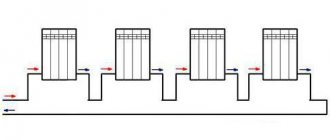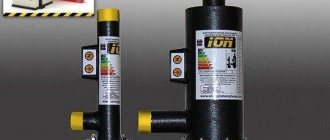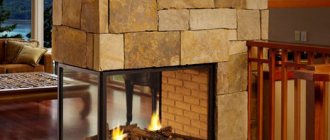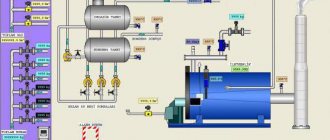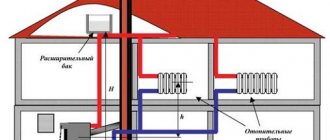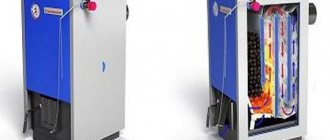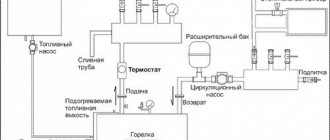General fire safety requirements for boiler houses are contained in regulations:
- main ones:
- SP 89.13330 (SNiP II-35-76), 62.13330 (SNiP 42-01-2002);
RF PP dated December 26, 2014 N 1521 “On approval of the list...” (list of applicable items);
Boiler room category for explosion and fire hazard
The boiler room is a room with a functional fire hazard class F5.1, respectively, categorized according to SP 12.13130. In SP 89.13330 it is assigned cat. D, but this provision is not categorical - calculations are carried out individually.
The boiler room almost always has a cat. D. In exceptional cases, if the calculation of the category shows this, one of the positions B is possible. Different parts of the building may have different values (see SP 89.13330).
Built-in, attached, roof-type structures are made with fireproof parameters no lower than those of the structures they serve. Detached buildings must fully comply with the rules for production facilities.
Other parameters for the PB classification are:
| Type | Fire resistance degree | Structural fire hazard class |
| Separate attached, built-in | I and II | C0 |
| III | C0, C1 | |
| Separate with reliability of release 2 tbsp. | IV | C0, C1 |
| Roof | III | C0 |
Fire safety standards for boiler houses
To understand safety rules and regulations, you need to know the laws that will help you avoid unnecessary paperwork and remodeling requirements.
Here are the main ones:
- SNiP 21-01-97* (SP 112.13330.2011) - about fire safety of buildings.
- RF PP No. 1521 dated December 26, 2014 - a list of mandatory standards, including those for gas systems.
- Order of Rosstandart dated October 3, 2011 N 5214 - a list of documents on the basis of which compliance with technical regulations on the safety of gas distribution networks is ensured on a voluntary basis.
- SP 62.13330.2011 - Gas distribution systems.
- SP 42-101-2003 - basic rules for the construction and design of gas distribution systems.
- PP No. 870 - TR for the safety of gas distribution networks.
- SP 402.1325800.2018 - rules for gas consumption design.
- SP 3 (4, 5, 6, 7, 10).13130 - rules ensuring the protection of fire systems.
- SP 60.13330 2021 - heating, ventilation and air conditioning.
- SP 402.1325800.2018 - “Residential buildings. Rules for the design of gas consumption systems."
- SP 89.13330.2016 - Boiler installations.
- Federal Law No. 123 - “TR on fire safety requirements.”
- PP No. 390— “On the fire safety regime.”
- NPB 105-03.
Of course, there are still a lot of rules and regulations, but these are the basics that will help you properly arrange a boiler room in compliance with all fire safety standards.
Requirements for the placement and premises of the boiler room
A boiler installation is a set of equipment with wall-mounted or floor-mounted heating boilers that converts fuel energy to create steam and heat water (coolant). For boiler houses from 36 kW, a special (dedicated) room is required.
Options:
- ceiling height from 2.5 m (for an object up to 60 kW - not lower than 2 m);
- volume 15 m³ plus 0.2 m³ per 1 kW;
- A ventilation window must be provided in gas-fired facilities.
The distance from the wall of an attached structure to the nearest window of the main building is from 4 m horizontally and from 8 m vertically. You cannot place (clauses 1.6 – 1.8 SP 89.13330 and clause 7.1 SP 62.13330):
- attached:
- adjacent to and above areas with simultaneous presence of at least 50 people;
from the side of the main facade of the building;
- roof and built-in – above/under production, high-traffic premises and warehouses (except for the installations themselves), buildings cat. A and B;
- built-in boiler rooms in multi-apartment housing, under public buildings;
- roof boiler rooms in apartment buildings adjacent to housing, if their ceilings are used as a floor or base;
- gas - in basements, plinths, with the exception of single-family and semi-detached housing, if this is not regulated by building codes;
- with boilers in basements with a flash point of gas or liquid fuel below +45 °C.
For preschool educational institutions, schools, medical and inpatient buildings of medical institutions, sanatoriums, and recreational facilities, only free-standing heating structures are equipped. Exception: for residential, public, domestic and administrative buildings, all types are allowed if the boilers heat the water to 115°C and with a pressure of up to 0.07 MPa.
Boiler rooms for stone and wooden private houses are possible. Experts recommend building free-standing or attached ones so that there are no odors in the house and to reduce risks.
General standards for arrangement:
- fire-resistant materials for wall decoration are non-flammable, at least flame-retardant. Moisture-resistant paints and varnishes are used for painting;
- finishing of floors and ceilings in the boiler room with non-combustible materials must correspond to its degree of fire hazard. Fully NG facings are recommended: ceramic tiles, brick, plaster, concrete;
- types of barriers from adjacent rooms for built-in and roof-mounted ones:
- walls – 2;
partitions – 1;
- floors – 3;
- flights of stairs from common building l/c are separated by sub-barriers with a resistance of 45 minutes. and types:
- partitions – 1;
floors – 3;
- for attached ones, use type 2 subwalls, NG ceilings, adjacent walls must have a fire resistance time of 45 minutes;
- for the walls of roof boiler rooms, the fire resistance time is from 0.75 hours, the spread of flame (FP) is zero. The roof of the main building and the area of 2 m from its walls is made of NG materials or protected with concrete/plaster (from 20 mm).
The room is provided, in addition to individual (regular, emergency), natural lighting with glazing in the amount of 0.03 m² per 1 m³. Domestic and service rooms for personnel or repair shops are prohibited in the boiler room.
Laying under foundations and structures is prohibited. A, B (except for GRP, GRPB, GNS, GNP) through gas ducts, balconies, utilities, ventilation, elevator shafts, l/c. Fuel lines are not located below the zero mark, stuffing box compensators are not allowed, as are extraneous loads.
Rules for arranging a work area
The most correct name for this space is the boiler room. It represents a certain space in which the boiler and additional equipment are installed: pipe distribution, pumps for forced supply of water flow, instruments for measuring temperature and pressure, various air conditioning and ventilation systems.
She usually becomes:
- Attic. A very common option that is found in almost every home. But it sometimes has to be seriously refurbished if the function was not determined at the construction stage;
- Basement. A more convenient option, which is why it is used more often. And in terms of safety, it is much more convenient - in extreme cases, you will not have to strengthen the surface on which the tanks are located;
- Separate building. The third type, which is used less frequently. This structure is attached to the dwelling after the construction of the general structure. Accordingly, for the connection it will be necessary to create new passages, as well as fit a new zone into the overall project;
- Utility room. Perhaps the best option. After all, the requirements according to SNiP regarding the volume and size of the boiler room for a gas boiler are strictly defined. And the technical rooms are precisely designed for them in advance and are calculated at the design stage of the home itself. The owner does not even know that this room meets all modern standards and conditions, because the design is usually carried out by professional construction companies.
However, installation is allowed in other locations. It's just difficult to adjust them to the required parameters. And it's just not very convenient. After all, according to SNiP, the area must be at least 15 cubic meters, and not every kitchen has that much free space. Moreover, there are also restrictions on the height of the walls; they must be no less than 2.5 m. This is a very high figure and it is not always possible to meet it.
There are also a number of other conditions related specifically to the combustion chamber. This is a separate exit directly to the street. This is often not provided for in the kitchen. It is also necessary to place windows throughout the entire space, which is at least 30 cm2 for every m3 of the working area. As a result, you will have to install several windows or one large one.
Fire safety requirements for gas boiler houses
The standard gas boiler room category is G (moderate fire hazard). It's not explosive. Chamber furnaces, main and/or liquefied gas are used.
Parameters and what the equipment should have:
- stagnant, non-ventilated (non-ventilated) zones are excluded;
- welded connections in pipelines;
- gas control units (GRU);
- easily resettable enclosing structures (reduce excess pressure during explosions);
- explosion safety valves;
- bends (each) with shut-off devices, gas burner equipment - with control devices;
- quick-acting and temperature-sensitive valves, flow measuring devices (for boilers from 1 MW);
- gas pressure up to 0.005 - 1.2 MPa (according to Table 2, 3 SP 62);
- They use steel and copper pipes with walls from 3 mm for underground pipes, and from 2 mm for external pipes. For the latter, reinforced PE is allowed (but not for LPG);
- laying depth from 0.8 m to the top of the gas pipeline;
- Pipes should be installed on blank walls or at a height of 0.5 m above the openings, but at least 0.2 m below the roof; they can be laid between windows with a gap of 0.2 m from each;
- Inside, installation is done in grooves or in floor channels with sealing.
For facilities operating on liquefied gas (LPG), the energy carrier is stored in tanks (gas holders) with control units. The recommended quantity is from two (above-ground and underground in an embankment). The distances are determined by the table. N 7 SP 62.
Fire safety requirements for solid fuel boiler houses
Rules for heating installations using solid fuels:
- supply of coal, firewood, peat, sawdust, pellets for equipment with a power of 1.16 MW and the process of slag extraction, if its volume is more than 150 kg/h, is mechanized (belt conveyors);
- Compacted soil is recommended for fuel storage areas;
- warehouse capacity: 2 – 14 daily supplies according to clause 13.12 of SP 89;
- stacks are placed 5 m to the fence, 2 m to the railway tracks, 1.5 m to the road;
- in warm objects, wet cleaning (hydrowash) is allowed;
- capacity of bunkers: for coal – reserve for 3 hours; for peat – by 1.5.
Requirements for a room with an electric boiler
An electric boiler and related devices are the safest of all types of heating, so there is no need to allocate a separate building or room for an electric boiler. There is also no need to equip ventilation and exhaust, and the boiler can be installed in any room of the house. The disadvantage of this equipment is volatility and high energy consumption. Requirements for a combustion room with a solid fuel boiler 1. The area of the combustion room is 8 m²; 2. Free access to all equipment; 3. The ventilation duct is calculated based on the proportions of 8 cm²/1 kW of unit power; 4. The boiler is installed on a separate foundation, as well as on a foundation - on a podium made of non-combustible materials up to 10 cm high; 5. Natural and forced ventilation is arranged in the same way as for gas equipment. The same applies to lighting – natural and artificial; 6. Building materials of walls, floors and ceilings must be non-flammable. A steel sheet measuring 500 x 500 mm is laid in front of the firebox; 7. The chimney must have a height of ≤ 5 m, with a number of turns or bends ≤ 3. When installing a gas or solid fuel boiler, it is recommended to carry out parallel installation of automatic protection, fire protection and other safety components and elements: bypasses, shut-off safety valves, temperature sensors, sensors smoke, other protective devices and equipment.
Fire extinguishing means in the boiler room
Fire safety in an electric boiler room
Block-modular boiler houses (mobile, autonomous) with a capacity of 35 - 3000 kW are common. Maximum service area up to 30,000 m². Requirements:
- distribution devices (minimum 2 sections);
- variable frequency drives;
- soft start and blocking devices;
- automatic switching on of reserve;
- laying of networks is open in boxes or in channels (wires in the lining), with the exception of wet areas and fuel supply;
- electrode boilers - three-phase, with connection to industrial frequency networks;
- pipelines with insulating inserts;
- grounding, grounding;
- the transformer station is not located in the boiler room, but nearby;
- electric boilers with protective fencing;
- all nodes are isolated from the ground and pipelines;
- automatic shutdown with alarm if there is a deviation in system performance;
- sign “Caution! Electrical voltage" at the input.
Fire safety rules for the operation of boiler installations with electric boilers take into account the PUE.
Fire safety standards in liquid fuel boiler houses
Requirements:
- fuel tanks:
- steel, reinforced concrete external with sprinkling or underground. For light types of fuel and additives, plastic ones with a safety certificate are allowed;
in climates from t° to +9 °C, make thermal insulation;
- capacity according to table 13.1 SP 89 (for 2 – 10 days);
- quantity: for main stock – at least 2; for backup – more than 1;
- consumable tanks are mounted outside the building, but they are allowed in separate boiler rooms;
- for block-modular placement, the main and receiving tanks can be combined;
- on fuel oil pipelines, bends, inlets:
- steel reinforcement 1 class. tightness;
seamless welded joints, and flanges only near the fittings;
- locking unit with manual and electric drive;
- connection to a flange for a plug with a release device;
- purge unit;
- emergency shutdown;
- for boilers from 1 MW - flow meter;
- control valve, as well as a slam-shut valve with an inertia of up to 3 seconds;
- check valve;
- on boilers with a capacity of 100 Gcal/h or more, a shut-off valve, an electrically driven shut-off unit, is installed in front of each burner.
Norms and rules for installing a gas boiler in a private house
Depending on the power of the gas boiler, you must select the installation location:
- If the power of the heating boiler is 150-350 kW, then it must be installed in the basement or first floor, and can also be installed in a separate building or an extension.
- If the power of the gas boiler is 60-150 kW, then the equipment can be installed on any floor, but in a separate room. Such a boiler can be installed in the basement or ground floor.
- If the equipment power is less than 60 kW, then you can install it even in the kitchen, but you must comply with all installation requirements.
A boiler that has low power can be installed in a separate boiler room. But usually such boilers are installed in a separate room along with other systems. For each boiler it is necessary to equip a room corresponding to its power:
- Power 60-200 kW – 15 m3.
- Power 30-60 kW – 13.5 m3.
- Power less than 30 kW – 7.5 m3.
If you decide to install a gas boiler in the kitchen, then the minimum volume of the room should be 15 m3, and the height to the ceiling should be more than 2.5 m.
Any premises are subject to rules and regulations. Let's look at the most basic requirements:
In a heating system with a gas boiler with a power of more than 60 kW, gas control must be installed. In this case, a gas leak will be automatically triggered and the gas supply will be stopped.
PB requirements for boiler placement
Distances for the boiler (according to R. 6 SP 89):
- the heat generator is not adjacent to any walls;
- access is open from any side;
- from the front to the opposite wall - at least 3 m;
- for gas boilers or those operating on liquid fuel - from 1 m from the burners, for mechanized fireboxes - more than 2 m;
- for heating devices with a capacity of up to 2.5 t/h, the distance can be reduced to 2 m;
- between two boilers:
- with mechanized fireboxes – 4 m and more;
on gas or liquid fuel - from 4 m, but the gap between burners is from 2 m;
- with manual loading – from 5 m;
- passages around - up to 1.5 m and up to 2 m for devices with a rate exceeding 4 t/h, if lateral maintenance is not required, then at least 1 m (but not from the front);
- the width of passages between individual protruding parts is from 0.7 m;
- free height – from 2 m.
“Podium” (backing):
- NG (concrete, brick, metal) with a thickness of 7 cm (standard 10 – 15 cm);
- protrusion of 10 cm around, in front of the firebox - 20 cm. The walls at the back and sides are lined with heat-reflecting screens;
- for a pre-furnace sheet made of steel, copper with a thickness of 1 - 2 mm, the dimensions are taken by analogy with clause 81 of the PPR: 0.5x0.7 (along) m.
Wall-mounted heating boilers are not installed in boiler rooms in the traditional sense of the term (not domestic). Mounted heat generators are rated according to different rules.
Types of boiler room
To organize a heating system in private houses and cottages, heating boilers running on gas, electric energy, solid and liquid fuel are used.
Boiler houses for heating on coal
This equipment operates exclusively on coal, for the storage of which a special place must be organized. There are almost no boilers that use only this fuel. Much more often units are produced that consume various types of solid fuel.
Solid fuel boiler room
Solid fuel boiler houses operate on coal, wood, peat, pellets, etc. The following mandatory requirements apply to their installation:
- Such a boiler room must be located in a separate room with an area of at least 8 m² and with ceilings more than 2.5 m high.
- The boiler must be provided with free access for loading fuel, carrying out preventive measures and repair work.
- The floor in the room must be made of non-combustible materials (concrete, tiles, etc.). A steel sheet must be laid directly in front of the firebox.
- The inside of the chimney needs to be plastered or an asbestos-cement (ceramic) pipe installed in it. The number of knees should be minimized (no more than 3). The design must include a special hole for cleaning and inspection. The diameter of the chimney must match the diameter of the pipe leaving the boiler.
- The premises require the presence of fire extinguishing equipment (fire extinguishers, etc.).
- It is mandatory to equip a combustion exhaust ventilation system at the rate of 8 cm² of cross-sectional area of the exhaust opening per 1 kW of boiler unit power (if located in basements - 24 cm²).
Electrical equipment does not require a boiler room, since during its operation no combustion products are emitted. There is no need to organize a chimney and ventilation. Electric heating equipment can be installed anywhere in the house, guided by the personal preferences of the owners.
Solid fuel and electric heating boilers can be installed on their own without the involvement of specialized personnel, because these units are not explosive.
Gas boiler room
Gas boilers occupy a leading position in terms of ease of use. When installing them, a number of fairly stringent requirements are imposed on a gas boiler room in a private house:
- Low-power appliances (up to 30 kW) are allowed to be installed within the house (kitchen, corridor, etc.). More powerful boilers are placed in separate rooms or attached rooms.
- The furnace area is at least 6-7 m², the ceilings are 2.2 m high and higher, the internal volume is about 15 m³.
- A window with a window is required. Its dimensions are taken at the rate of 1 m³ of internal volume of the boiler room per 0.3 m³ of window.
- There must be non-combustible material under the boiler (flat slate, sheet of metal, tiles, etc.). A distance of more than 0.7-1 m must be maintained from the boiler to furnishings.
- Air intake openings must be provided.
A separate gas boiler room in a private building requires compliance with the following additional installation conditions:
- the foundation of a residential building must be isolated from the foundation of the furnace;
- the gas boiler is placed on a special concrete base (15-20 cm high), which is poured separately immediately before installation of the equipment;
- materials used for the construction of walls and roofs must be non-flammable;
- door passage width - at least 0.8 m;
- The smoke exhaust system requires installation on its own separate foundation.
Units with a power of more than 60 kW are required to be equipped with a gas leakage monitoring system, which turns off its supply if the maximum concentration in the air is exceeded.
Liquid fuel boiler room
A liquid-fuel boiler room in a private house can run on fuel oil, waste oil, diesel fuel, etc. There are no strict requirements for what such a furnace room should be, since installation of such equipment does not require permission. But such a boiler room must be a separate building or room with a separate entrance and meet the following requirements:
- combustion area - at least 15 m², ceilings - at least 2.5 m, volume - from 15 m³;
- the walls of the furnace room must be lined with non-combustible materials;
- the boiler should be located on a metal frame or concrete podium at the maximum distance from windows and doors;
- there must be an air flow;
- The indoor fuel storage tank can have a volume of no more than 800 liters.
Equipment of this type is convenient when there is no possibility of connecting to a gas pipeline.
Safety regulations for chimney placement
Requirements for smoke exhaust take into account ordinary and industrial regulations (SP 43.1333, 7.13130). Rules:
- install one pipe, two or more - upon technical justification;
- gate with a hole of 50 mm in the upper part;
- for boilers with forced-air burners, individual chimneys or common ones with separating inserts are installed;
- if there are more than 3 boilers and with an outlet diameter of 3.6 m or more, install a multi-barrel structure;
- materials: reinforced concrete, brick, metal, fire-resistant plastic, ceramics;
- at the junction of gas ducts - temperature-sedimentation joints, compensators;
- manholes, hatches for cleaning;
- ash collection devices, condensate drainage;
- lining with brick, concrete, metal, thermal insulation;
- outlet (exhaust path from the installation to the chimney):
- vertically from the boiler at least 500 mm;
- branch – up to 1 m, number of turns – up to 3;
horizontal section with an upward slope of 2°;
- brick or concrete body – from 130 mm;
ceramic – from 250 mm.
If flammable structures are adjacent to the chimney, they are protected with offsets or cuts that reduce the rate of fire spread. The first is a gap of 260 - 500 mm. The second is a thickening of the pipe from 500 mm if the fences are flammable, and from 380 mm if with fire protection. Width – 70 cm more than adjacent structures.
Primary fire extinguishing agents
The boiler room has subclass F5.1 (industrial buildings), accordingly, they comply with the standards for fire extinguishing agents.
A fire shield is needed if there is no fire hydrant, AUPT, and the distance to water intake points is more than 100 m. A box of sand (from 0.5 m³) is required for fire class. B, E. The procedure for using primary fire extinguishing agents is prescribed in the safety instructions.
What fire extinguishers should be in the boiler room?
In boiler rooms, the fire class is usually A, B, C, and also E (electric boiler fire). According to the table NN 1 and 2 PPR (post. N 390) conditions for manual fire extinguishers are as follows:
| Fire class | Number and fire extinguishing capacity of fire extinguishers |
| A | 2 – 6A 1 – 10A |
| B | 2 – 144B 1 – 233B |
| E | 2 – 6A, 144BCE 1 – 10A, 233BCE 2 – 144BCE 1 – 233BCE |
| WITH | 2 – 6A, 144BC 1 – 10A, 233BC 2 – 144BC 1 – 233BC |
According to the table 1 NPB 166 list of fire extinguishing means in the form of fire extinguishers is as follows:
| Boiler room category | Maximum area, m² | Fire class | ORP, 10 l | , l | for 2 (3) l | , l | |||
| 2 | 5 | 10 | 2 | 5 (8) | |||||
| G | 800 | B | 2 | – | 2 | 1 | – | – | – |
| C | – | 4 | – | – | – | ||||
| G, D | 1800 | A | 2 | 4 | – | – | – | ||
| D | – | – | – | – | – | ||||
| E | – | 2 | 2 | 4 | 2 | ||||
According to SP 41-104-2000 clause 14.2, mobile OPs are prescribed for areas up to 150 m³; additional standards are in Table. N2 NPB 166. It is recommended to follow the rule: the boiler room must have at least 2 fire extinguishers.
Boiler room installation
The heating system in a private house includes not only a boiler and pipes, but also other devices and communications that are no less important for its effective functioning, located in the boiler room in a private house according to a certain, pre-calculated and specified pattern.
The heating system consists of:
- heating boiler, which is a heat generator. Thanks to the fuel burning in the combustion chamber of the boiler, the coolant heats up, and the heat from the pipes and radiators flows from the boiler room in a private house into the room.
- water heater tank. The purpose of the boiler is to provide the inhabitants of a private house with hot water. A heated coolant circulates through a tube passing inside the water heater tank, due to which the water in the boiler is heated.
- distribution manifold, consisting of a circulation pump, hydraulic distributor and comb. The main purpose of the distribution manifold is the most convenient distribution and circulation of coolant in all devices of the heating system, as well as maintaining the temperature of the coolant.
- expansion tank, necessary to compensate for the increase in pressure in the heating system due to heating of the coolant.
- a safety group that protects the heating circuit from excess pressure and removes excess air. This group includes: pressure gauge, air vent and safety valve.
- chimney. The safety and efficiency of the heating system largely depends on the correct calculation and installation of a chimney in a boiler room in a private house, the installation of which is carried out according to a certain scheme.
- pipelines, shut-off valves used to shut off the flow of the medium
- a make-up system that monitors the decrease in coolant pressure in the heating system due to evaporation or various other leaks.
- automation, which is an electronic device that allows full control of a gas boiler room in a private home.
What kind of door should be in the boiler room?
Door parameters:
- canvas width from 0.8 m;
- opens outwards;
- the exit must necessarily be outside from the basement/basement segments of the building if the power is above 150 kW (clause 6.18 of SP 42-101-2003);
- for an area larger than 200 m² - from 2 exits. For less – 1, but in the presence of evacuation;
- the doors of the service and household premises open in its direction;
- for roof boiler rooms, there is an exit to the roof and a second one from the main building;
- in built-in varieties, access to the street or into the house is required, but with a vestibule.
For exit to the adjacent building - only fire doors with closers, fire resistance limit as that of the enclosing structure (for power from 60 kW - EI 45 and above); to the street - any door leaves. Thresholds are not used if the ventilation gap with a cross-section of 0.2 m² is made at the bottom of the doors, and not at the top (above the doors, under the ceiling).
Standards and requirements
For each type of boiler, there are additional requirements for placement, operation and safety, described in SNiP 42-01-2002. The basic general requirements for a boiler room in a private house with gas equipment include: permission to install a boiler ≤ 30 kW not in a separate building or room, but in the house. The room must have a ceiling height ≥ 2.5 m, area ≥ 6 m2, volume ≥ 15 m3. Usually, a kitchen is used to install gas boilers, and it is necessary to focus on the power of the boiler - the larger it is, the larger the area and volume the room should have. The minimum window area in the kitchen is 0.5 m2, door width ≥ 0.8 m. In any room with gas equipment for heating the house there must be natural and forced ventilation; to ensure natural ventilation in the kitchen, holes of size ≥ are made at the bottom of any wall or door 30 x 30 cm, forced ventilation is provided by installing a hood. If the boiler has a power ≥ 30 kW, it must be installed in a separate building or room. When installing a boiler in a house, the following conditions are taken into account: 1. A separate door to the street; 2. Artificial and natural lighting; 3. Availability of artificial and natural ventilation and/or exhaust; 4. Fire resistance of walls.
Ventilation diagram
Smoke removal from the boiler room
Solid fuel installations are equipped with flue gas purification systems (ash collectors). Gas ducts must be free of ash deposits. When using wood fuel, “wet” spark arrestors are installed. Each boiler is equipped with draft units (smoke exhausters, fans).
Supply ventilation should provide 3 air changes in 1 hour and a sufficient supply of oxygen for the burners. For each kW, 8 cm² of cross-sectional area of the ventilation duct will be required, or 30 cm² if the air is taken from the building system.
Instructions on fire safety measures in the boiler room
The fire extinguishing plan and compliance with safety regulations are specified in several versions of instructions for each type of room. The document establishes the responsibilities of personnel who must undergo emergency and fire training.
An example of the main aspects of instructions on fire safety measures in a boiler room:
- personnel actions must ensure the evacuation of workers and the organization of fire fighting before the arrival of firefighters;
- operator (stoker) actions:
- call the fire department;
stop and de-energize the equipment;
- when gas pipelines catch fire, the pressure is first reduced to a minimum, then the flame is extinguished, and then the gas is turned off;
- general fire safety measures:
- before lighting the boilers, check their serviceability, ventilation, control units;
the fireboxes are ventilated for 10–15 minutes by opening the dampers and/or turning on the smoke exhausters for 3–5 minutes;
- traction is checked;
- Drying any items on or near boilers is prohibited;
- the tightness of gas pipelines is checked with a soap solution;
- It is forbidden to supply fuel when the burners are extinguished, as well as ignition without pre-purge;
- checking water level and pressure is mandatory;
- When stopping the boiler, you must disconnect it from the main line and open the purge plug.
Download: Sample instructions on safety measures in a solid fuel boiler room.pdf Download: Sample instructions on safety measures in a gas boiler room.doc Download: Sample instructions for a boiler room operator.doc
Is it possible to install a suspended ceiling in a boiler room?
A boiler room is a separate room in which equipment is located that provides the house with heat and hot water. Most often, a separate building is built for these purposes, however, some types of boiler rooms are located directly in the house. Basically, this room remains without any finishing: an ordinary concrete floor and walls are quite enough for the normal operation of the equipment. Luxurious finishing materials are used here quite rarely: the main thing is that the boiler room is safe and functional. However, many ordinary people want even this rarely visited room to look aesthetically pleasing.
Therefore, they prefer to make at least minimal repairs to it. For the floor, tiles are mainly chosen, for walls - plaster or plasterboard. But the design of the ceiling remains a real problem. Many customers in this situation wonder whether it is possible to install a suspended ceiling in the boiler room.
Requirements for finishing materials for a boiler room
Regardless of the room in which the boiler room is located, certain requirements are imposed on its equipment and finishing. The most important of them is compliance with fire safety standards. In accordance with them, there should be no flammable materials in the boiler room, as they can lead to a fire and explosion of the equipment. That is why it is strictly forbidden to use plastic, wood and paper-based materials to decorate this room.
In addition, when designing the ceiling space, one important requirement must be met: all electrical wiring must be hidden. Also, the ceiling must be heat-resistant, because when using some equipment, the temperature in the boiler room reaches quite high levels.
We have become familiar with the basic standards. Now you need to understand whether it is possible to install a suspended ceiling in the boiler room. Will the use of such finishing violate fire safety requirements?
The feasibility of using a suspended ceiling in a boiler room
Very often, ordinary people want to use suspended ceilings to decorate a boiler room, because they are quick to install, durable and easy to maintain. Professional craftsmen claim that such coatings can be safely used in such specialized premises. And there are several reasons for this.
- Stretch ceilings are fireproof. They do not ignite and do not support the combustion process, therefore they correspond to the highest safety level M1. What is important is that no flammable components are used when installing the tension structure. However, not all materials on the market today meet this characteristic. Some unscrupulous manufacturers add components to PVC films and fabrics that not only cause the ceiling to catch fire, but also release toxic substances during combustion. In order for tension coating to be used in a boiler room, it is necessary to find a company that uses certified fabrics whose fire safety is confirmed by relevant documents.
- Under the suspended ceiling you can hide electrical wiring and other communications. It will also allow you to easily hide the ventilation elements that must be in the boiler room.
So, is it possible to use a suspended ceiling in a boiler room? There are no restrictions on the use of this finishing method, because it will not violate fire codes and requirements. In addition, the temperature in this specialized room is practically no different from the temperature in a regular residential building, so you don’t have to worry that the canvas will overheat and become deformed.
What should you consider when installing a ceiling?
If you decide to install a suspended ceiling in the boiler room, the installation of the structure should be entrusted to professionals. The fact is that in the process of finishing the ceiling several difficulties may arise. The first of these is that the chimney from the boiler most often exits through the ceiling. This element is characterized by quite strong heating during operation of the equipment. If the chimney comes into contact with the suspended ceiling, it can overheat and melt it. To prevent this from happening, it is necessary to correctly bypass the pipe. To do this, you should use special thermoelements that will protect the stretch ceiling from deformation.
Since suspended ceilings can impair air circulation in the boiler room, when installing them it is extremely important to carefully consider the ventilation system. It can be located under a tension structure and have exits to the room.
Now you know whether it is possible to install suspended ceilings in a boiler room, and how to comply with all safety standards. You can order installation of a high-quality and fireproof tensile structure at.

